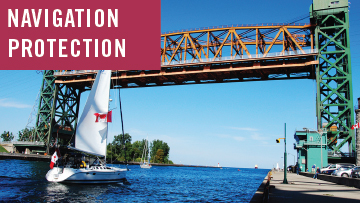Environmental and Regulatory Reviews: Proposed Approach

Read the discussion paper
The Government of Canada has outlined a proposed new approach to environmental assessments and regulatory reviews with a potential path for good projects to proceed in partnership with Indigenous peoples and effective, science-based, enforceable conditions, with clear timelines. You can review this new approach outlined in a discussion paper.
Early engagement and planning: Collaborative approach will support better project design.
Partnering with Indigenous peoples: A deepened relationship, which will include a single organization for Crown consultations and an emphasis on building economic opportunities.
Science and knowledge: Integrated national science and open data platform and new energy information agency will increase transparency, demonstrate how science and evidence (including Indigenous traditional knowledge) is used.
Cumulative Effects management: taking a deliberate approach to assessment and management of cumulative effects through national environmental frameworks, regional assessments and management initiatives.
Openness, accessibility and transparency: Easy online access to opportunities for public participation and two-way dialogue.
A broader assessment lens: Environmental assessments would transform to Impacts Assessments and include environmental, social, economic and health impacts.
A single agency approach for impact assessments: Joint assessments for major projects with federal life-cycle regulators would combine processes to enhance efficiency and effectiveness.
Explore the proposed process
The following diagram outlines proposed changes to Canada’s environmental assessment and regulatory process, building on positive features of the current system. For more details, read the discussion paper on the web or download the PDF version.

Text version
Government Decision Making on Projects
Strategic & Regional Assessments as applicable in order to assess Cumulative Effects
Early Engagement & Planning
- Designated projects would be subject to an Impact Assessment process and project decision prior to regulatory decision(s).
- Non-designated projects requiring federal actions or permits would not be subject to an Impact Assessment but would be subject to a regulatory review by regulatory departments or lifecycle regulator (National Energy Board, Canadian Nuclear Safety Commission, Offshore Petroleum Board) prior to associated regulatory decision(s).
Ongoing
Monitoring, Compliance & Enforcement & Follow Up
Partnering with Indigenous Peoples
Science, Evidence and Indigenous Knowledge
Cooperation with Jurisdictions
Transparency and Public Participation
Next steps
Canadians were invited to read the discussion paper and share their views during a public comment period that was held from June 29 to August 28, 2017.
In terms of next steps, the feedback gathered on the discussion paper from Canadians, as well as input from Indigenous Peoples and stakeholders will help inform potential legislative, regulatory or policy changes.
Background to the discussion paper
The Government of Canada has committed to reviewing and modernizing environmental assessment and regulatory processes. Our goal is to protect the environment and introduce modern safeguards, support reconciliation with Indigenous peoples and ensure that good projects go ahead and resources get to market sustainably.
Over the past year, the Government of Canada has undertaken a review of environmental and regulatory processes. The review included in-person and online engagement through:
- An expert panel review, on federal environmental assessment processes;
- An expert panel, on modernizing the National Energy Board; and
- Standing Committee reviews on restoring lost protections and introducing modern safeguards to the Fisheries Act and the Navigation Protection Act.
Canadians from across the country participated in this process, and let us know what’s important to them as we work to rebuild public trust in our processes.
We heard common themes from these reviews including:
- Be inclusive: Invite Canadians to participate from the earliest planning stages through to the end of a project.
- Be transparent: Ensure decisions are based on the best available expertise, science and evidence.
- Keep project reviews focused: Don’t address complex policy issues as part of the review of projects.
- Recognize Indigenous rights: Include Indigenous peoples as partners in the economic development of their territories.
The Government of Canada is contemplating a series of changes, with the views of Canadians in mind.
Page details
- Date modified:










